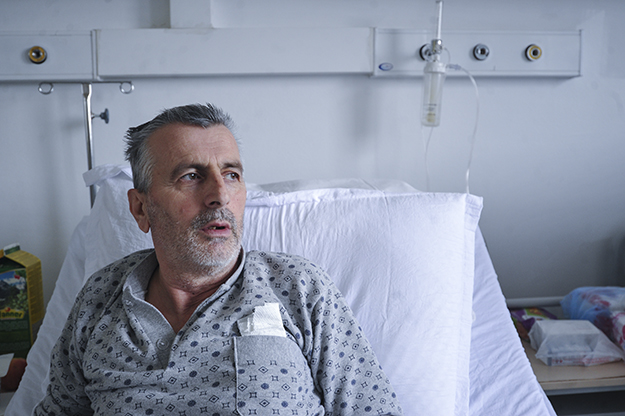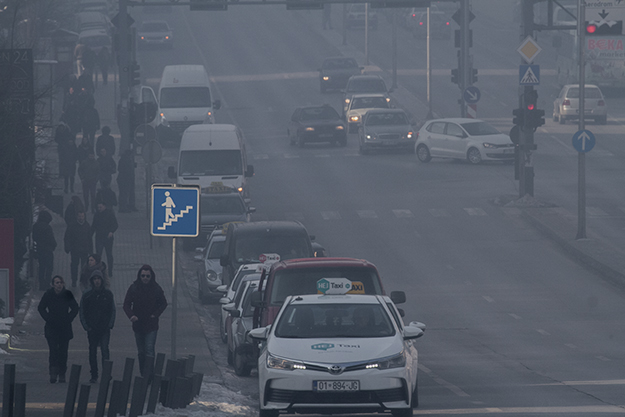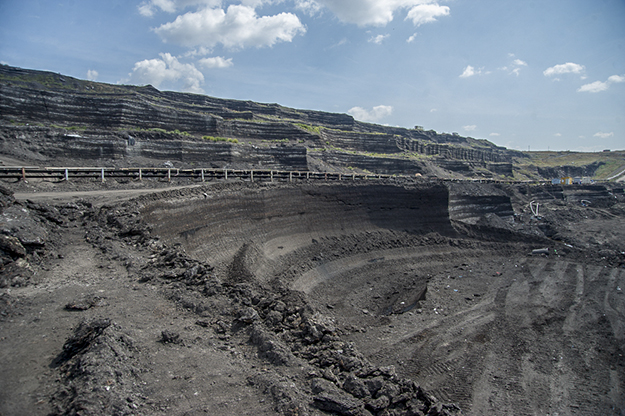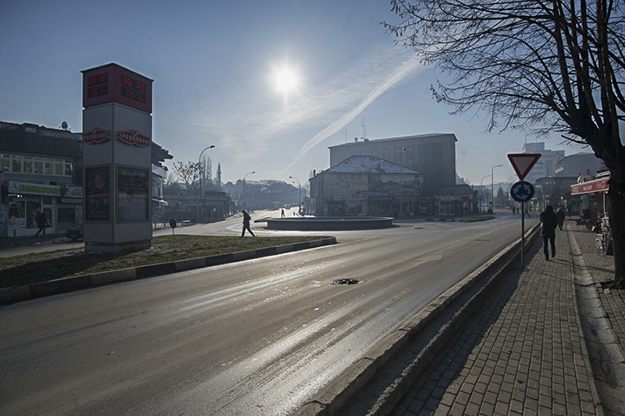On a cold winter’s afternoon, outside one of the clinics of Prishtina’s University Clinical Center of Kosovo (QKUK), a man stands near the main entrance passionately smoking a cigarette. As he does so, he stares intently at the glass panel of the door, reading a notice that warns of a serious flu epidemic.
The corridor leading from the main entrance of the Pulmonology Clinic is filled with people, most of them old, patiently waiting in front of a small reception window in order to get permission to talk to the doctors about their problems.
Upstairs, on the second floor, the corridors have been transformed into a working area due to an ongoing renovation process. Despite the disruption of the ongoing work, one of the four patients in the first ward along the corridor seems to be in fairly good spirits as he lies in bed receiving treatment.
Isan Bulliqi, who the nurses and patients have dubbed “professor,” is only too willing to talk, perhaps to break the dimly lit room’s generally gloomy atmosphere, which is broken occasionally by the coming and going of nurses and patients’ relatives.
Bulliqi has been hospitalized for a number of days and is suffering from severe lung inflammation and related issues affecting his pulmonary tract. It’s a condition that he is convinced is caused in no small part by the polluted air in his neighborhood of Tophane.

In winter, Isan Bulliqi suffers from lung and pulmonary problems that he believes are intrinsically linked to Prishtina’s polluted air. Photo: Atdhe Mulla / K2.0.
Usually, he would be setting about his daily commute on public transport to his place of work in the administration of the Palace of Justice, a big complex containing a number of courts and justice institutions in the outskirts of Prishtina.
“When I go out to go to work, I have to walk for a bit from my house to the bus stop in the Qafa neighborhood,” he says. “During this walk, I cover my mouth with a scarf so as not to breathe in the polluted air.”
Bulliqi believes that the primary causes of pollution in his neighborhood are the heavy traffic and residents burning coal for heating, a common practise due to its relative cost compared to other potential options.
“I myself have burned coal in my house,” he says. “This is not something that you should hide.”
But like many residents and visitors to Prishtina, he feels the effects.
“My health [condition] is mainly exacerbated by air pollution, especially in winter because during summer the air is better,” he says. “This has not only been the case in recent years; negative effects don’t become apparent overnight. Rather, pollution produces these effects over time.”
The ‘invisible killer’
It’s no secret that Kosovo’s capital is overwhelmed by air pollution, especially during wintertime when the air is filled with dangerous particles and the potent smell of smoke lingers long in the nose.
But since March 2016, the U.S. Embassy’s Air Quality Index has actually enabled citizens to see the real time condition of the air with detailed information regarding pollution levels.
Data provided from measuring equipment installed on the Embassy site alarmed citizens in winter 2016, as comparisons showed that Prishtina was high on the list of Europe’s most polluted cities; it also often featured among the most polluted places in the world, up there with cities in China, India and other countries with highly developed industries, which are widely considered to be one of the main causes of global air pollution.
With citizens now having the opportunity to check the real time air quality online, civil awareness of — and consequently response to — the issue of air pollution became a hot topic, and for the first time, Kosovo’s institutions began to feel the pressure from citizens for better air quality through protests.
In December 2016, Peer Educators Network and the Science for Change Movement attempted to raise general awareness about the “invisible killer” and the consequences brought to people’s health by organizing symbolic actions in the center of Prishtina.
Just over a year later, in January 2018, hundreds of citizens protested in front of the National Theater in Prishtina, raising their voices and calling for more clear cut decisions by the institutions to fight the pollution. After many days of the measuring devices having shown “hazardous” levels of pollution, this protest marked the peak of the public reaction and concern about the presence of pollutants in the air.
However, recent research shows that the majority of Kosovar citizens still have little awareness of the potential risks of air pollution to the environment and to their health.
A UNDP report, Public Pulse, published in February 2019, found that 55% of Kosovars have little or no knowledge of potential environmental threats to their health, while 38% reported that they are somewhat informed about these issues.
Another report, published in 2018, suggests that Kosovo has much to be concerned about.
The report on air quality by the European Environment Agency (EEA) published results of analyses of atmospheric components that are present in the air in the form of PM2.5 particles — atmospheric matter with a diameter that is smaller than 2.5 micrometers, or 3% of the diameter of a string of hair — nitrogen dioxide and ozone.
According to the report, Kosovo has the dubious honor of boasting amongst the highest concentrations of PM2.5 particles in Europe, alongside Bulgaria, Serbia, North Macedonia and Hungary. The subsequent health impacts, relative to size of population, are also said to be greatest in these countries.
The EEA stated that in 2015, 3,700 people in Kosovo alone suffered premature deaths due to PM2.5 particles, while 190 others died from exposure to ozone and nitrogen dioxide.
Some however urge caution with regard to the precise figures in the report.
Skënder Baca, a specialist doctor in the Pulmonology Clinic in Prishtina, says that while air pollution is one of the factors that contributes to the exacerbation of health conditions related to the pulmonary system, it is not necessarily the main cause of casualties related to these issues.
“We must come to a logical cause and effect relationship between air pollution and its effects on the human body,” he says. “Luckily, its effects on the human body are relatively low, despite the at times enormous amount of pollution.”
The doctor does acknowledge that polluted air can affect the respiratory tract, and can also impact other parts of the body, such as the hematopoietic system, which involves the formation of blood cells. This is especially true for cases of poisoning from vehicle gas emissions, he says, which contain a considerable amount of heavy metals, such as lead.
“We must also protect ourselves by consuming liquids, so that the pulmonary tract’s protective system never remains dry,” he says. “Dryness in the respiratory system is unfavorable because viruses, dust and allergens stick more easily.”
Michael Brauer, a professor of public health at British Columbia University in Canada, says that the negative impacts of air pollution on human health are significant.
“While breathing, humans swallow millions of very tiny particles of polluted air, which the body identifies as foreign bodies and tries to eliminate,” he says. “Being unable to do this, inflammation is created after the body continues to try to eliminate these agents unsuccessfully. In essence, it is like you are causing the body continuous injury.”
Brauer says that because of this condition the body goes into a state of high protection, continuously producing molecules to fight foreign elements, with the damage spreading to all body parts, including the heart and other vital organs.
A study published last November by the University of Chicago states that polluted air surpasses smoking, alcohol and drugs as the main cause of premature death in the world. According to the study, polluted air emitted by burning fossil fuels is shortening the average lifespan on a global level by 1.8 years, as such becoming the main curtailer of human life.
Brauer does not fully agree with the conclusions of this data, however, drawing similar conclusions to Baca about the difficulties in drawing a direct correlation between air pollution and premature death. He suggests that this is not the case with other causes of premature death, such as smoking, and that the bigger problem with air pollution is the fact that the number of people who are exposed to it is much higher than with other public health hazards.
He emphasizes that air pollution is still a serious contributing factor to health problems and that inhaling polluted air for a number of consecutive years is enough to expose people much more readily to severe illnesses.
“Air pollution contributes to illnesses; for example, if a person is suffering from some illness, such as moderate diabetes, or is a consumer of tobacco or alcohol, air pollution contributes to exacerbating the problem,” he says. “Elderly people and children are most vulnerable, because polluters even hinder the fight against bacterial infections in the pulmonary tract.”
More and more scientists are further stating that the effects of air pollution on the human body are likely to be more widespread than previously thought. Studies have shown that air pollution may have an impact on intelligence and mental health.
Its effects on pregnant women are also thought to be potentially severe.
A study conducted at the Queen Mary University of London showed that there is a strong relationship between air pollution that women inhale during pregnancy and damage to the foetus.
As part of the study, they examined five women who didn’t smoke and gave birth to healthy babies. By isolating cells that are part of the immune system, scientists came to the conclusion that particles of smoke and soot went past the lung’s filters and penetrated all the way to the placenta.
Although the exact level of damage caused by smoke particles to the placenta is as yet unknown, through other studies scientists have argued that polluted air particles increase the likelihood of premature birth and the birth of underweight babies; this in turn can have permanent negative effects on a child’s health.
Stopping the source
While the effects of air pollution are becoming increasingly well researched and documented, doing something about its causes in Kosovo is proving a tougher nut to crack.
Nezakete Hakaj, who leads the Ministry of Environment and Spatial Planning’s Department of Environmental Protection, says that at least part of the problem is that the topography of Prishtina is unfavorable.
With a large part of the city sitting in a valley surrounded by hills, Hakaj says that the buildup of pollutants is contributed to by the natural fog that often sits over the city in winter and the cold weather, which keeps dust and other pollutants down closer to the ground.
The phenomenon is known as temperature inversion, and occurs in many cities surrounded by hills, including nearby Skopje. Effectively, warmer air, which would normally be found closer to the surface of the earth, traps cooler air — and any pollutants within it.

During winter days, Prishtina is often covered by a blanket of dangerous thick smog, an issue partly brought about by its topographical surroundings and climatic conditions. Photo: Fikret Ahmeti / K2.0.
Experts agree that the air in Prishtina and some surrounding areas is polluted virtually year-round but that the atmospheric conditions play an important role in exacerbating the problem in winter. Data gathered by the Science for Change Movement confirms that air quality in Prishtina is at its worst during the winter, especially during January, whereas the least polluted air is found in June.
While little can be done about the natural environmental conditions, the level of pollutants being emitted is down to the human factor.
With burning coal for heating seen as a major contributor to air pollution, in September the Ministry of Education decided to ban its use in every pre-university school building. But while many schools seem to have made the switch, coal is still the primary source of fuel in many households.
Another contributing factor is vehicle emissions. According to the Kosovo Agency of Statistics, Kosovo has around 300,000 automobiles, many of which are more than 10 years old and would be far from meeting EU emissions standards for new vehicles.
The biggest cause of air pollution in Kosovo however is widely considered to be the lignite burning Kosova A and Kosova B power stations in Obiliq, just 10 kilometers outside the capital. Built in the 1960s and 1980s respectively, the power plants are outdated and are amongst the worst polluters in Europe. Kosova A was due to be commissioned in 2017, but instead limps on, although two out of its five units are no longer in use.

Kosovo has a rich source of lignite, a form of coal that is used widely for domestic heating as well as in the two aging power plants in Obiliq just outside Prishtina. Photo: Atdhe Mulla / K2.0.
With the outdated infrastructure and the energy produced not enough to meet Kosovo’s demand, the government has developed plans to build a new coal-based power plant, Kosova e Re. However in October 2018, the World Bank decided to pull out of plans to fund the project because of concerns over the environmental impact and the increasingly affordable renewable alternatives, while the EU has also expressed concerns about Kosovo’s reliance on coal-based energy. Nevertheless, the government has not backed down from its plans and is looking for alternative funding.
Such institutional insistence on coal seems at odds with efforts — at least on paper — to build a solid environmental legislative framework.
A Law on Environmental Protection has been in force since 2009, although it does little to specifically tackle air pollution. Since 2010, Kosovo has also had a specific Law on Air Protection from Pollution, however it is not considered to be in line with EU standards.
In light of this, a new Draft Law for Protection from Pollution is being legislated, aimed at directly targeting the sources of air pollution and offering a wider range of legal instruments and obligations as to how businesses and others should act in order to combat pollution. The Draft Law is currently in the committee stage, having been adopted at first reading by the Assembly.
In 2013, Kosovo’s government also approved a Strategy for Air Quality 2013-2022, through which it attempted to identify key elements of the problem of air pollution in Kosovo and announced what actions the government foresees to improve the air quality and the environment in general. However, the Strategy barely touches upon the effects of air pollution on the human body, providing just a single, short paragraph on this issue:
“It is widely known that air pollution can have negative effects on the environment, and human health and comfort. However, it is difficult to determine the level of these effects. A series of studies have been conducted in relation to the effects of air pollution. These studies show that air pollution is not only damaging to health, but also the environment.”
Perhaps unsurprisingly, citizens have noticed little improvement in air quality in recent years, hence the protests that culminated in January 2018.
In the face of this public pressure, the Municipality of Prishtina, in cooperation with the Ministry of Environment, attempted to urgently lower the air pollution in the capital by banning the sale of coal within the city limits and creating a no-go zone for cars around the city center. This restriction was short lived though, and was lifted within 48 hours.

In January 2018, the Municipality of Prishtina reacted to public pressure over hazardous air by temporarily banning vehicles from the center of the capital. Photo: Atdhe Mulla / K2.0.
The protest also forced an extraordinary session of the Assembly, with deputies approving a resolution against air pollution.
The Assembly resolution, which contains 19 points, foresees the government prioritizing work to improve air quality, and undertaking a series of concrete actions to achieve this goal, including the installment of adequate filters in the power plants by the end of 2018, a ban on burning coal for heating in collective buildings and an increase in capital investments for the Termokos enterprise, with the aim of expanding the central heating network in Prishtina and other cities.
Asked about the implementation of the Assembly resolution, Hakaj from the Ministry of Environment says that the Ministry has always worked hard to fight air pollution, but that the government in general has been forced to prioritize the issue more highly since the publication of air quality measurements by the U.S. Embassy.
Hakaj also urges caution in expecting short term results, arguing that tackling air pollution is a complex issue with many interrelated factors.
“To fight pollution, the general economic condition of the population is very important,” she says. “We agree that the use of coal in households is one of the things that pollutes the air, but we have to be careful because we can’t forcibly stop people from burning coal to heat their houses.”
Hakaj also insists that the Ministry needs a bigger budget in order to increase efficiency in the fight against pollution.
While the government has repeatedly said that the fight for better air will be one of its main priorities, its budgetary plans don’t exactly reflect the words.
Despite the Department of Environmental Protection seeing an increased budget allocation in 2019 compared to previous years — 3.5 million euros, compared to 1.2 million in 2018, and 0.4 million in 2017 — the increase has almost exclusively been in capital investments, none of which are directly connected to improving air quality.
Similarly, the budget of the Kosovo Environmental Protection Agency (KEPA), an institution specifically intended to protect the environment, has seen its budget allocation linked to air quality monitoring frozen in recent years at just 150,000 euros per year.
With the relative lack of institutional action, it’s perhaps unsurprising that air conditions in the capital were once again hazardous this winter, leaving citizens such as Isan Bulliqi to feel the effects.
The coming of spring may bring some temporary respite, and for many it will be a case of “out of sight, out of mind.” But without a concerted long term effort to tackle it, air pollution will continue to be Kosovo’s silent assassin.K
Feature image: K2.0.





